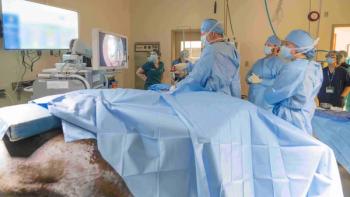
MRSA: What every veterinarian needs to know (Proceedings)
Beginning with Alexander Fleming's discovery of penicillin there has been an ever escalating arms race between microbes and the doctors that treat life-threatening infection.
Beginning with Alexander Fleming's discovery of penicillin there has been an ever escalating arms race between microbes and the doctors that treat life-threatening infection. Fleming's discovery saved countless lives; however, it did not take long for bacteria to respond by developing mechanisms for resistance. Staphylococcus aureus was amongst the first to develop resistance to penicillin. Most penicillin resistance was, and continues to be, secondary to the production of beta-lactamase. Scientists responded by developing beta-lactam antibiotics which are resistant to the effects of beta-lactamase as well as other classes of antibiotics which are not effected by beta-lactamase.
Methicillin is a beta-lactamase resistant penicillin developed in the 1950's. Shortly after its introduction the first methicillin-resistant Staphylococcus aureus (MRSA) isolates were identified in Great Britain. MRSA rapidly spread across the globe. MRSA developed resistance by acquiring a plasmid the coded for a novel penicillin binding protein in the cell wall, penicillin-binding protein 2a (PBP2a). PBP2a was unique in that this mutation makes the organism resistant to all beta-lactam antibiotics (penicillins, cephalosporins, and carbapenems). Methicillin is no longer used clinically so methicillin resistance itself is of little concern. Instead oxacillin, a more stable drug, is used in antimicrobial sensitivity testing. Methicillin/oxacillin resistance is important since an organism that is resistant to methicillin/oxacillin will be resistant to all beta-lactam antibiotics. The term MRSA is still used to describe such isolates, however, a more appropriate term would be beta-lactam resistant Staphylococcus aureus.
PBP2a is coded by the mecA gene that is found on a large mobile genetic element called the staphylococcal chromosomal cassette mec (SCCmec). There are four SCCmec commonly identified. Each codes for a different combination of antimicrobial resistance in addition to the PBP2a. As a result, MRSA is commonly resistant to multiple classes of antimicrobials.
MRSA isolates commonly encountered in veterinary patients
MRSA in people
Methicillin-resistant Staphylococcus aureus (MRSA) has traditionally been considered a healthcare-associated pathogen in patients with established risk factors. More recently, however, MRSA infections have been described in community-dwelling patients without established risk factors for the acquisition of MRSA. MRSA has become a worldwide problem, although its prevalence varies considerably among countries. Consistently high prevalence rates are found in the USA, South America, Japan and southern Europe, whereas prevalence rates are low in Scandinavia, The Netherlands and Switzerland. Several investigators have suggested that the epidemiology of MRSA is changing, as infections are increasingly reported in healthy community-dwelling individuals without healthcare-associated risk factors for the acquisition of MRSA]. Clusters and outbreaks of these so-called CA-MRSA infections have been described in more-or-less 'closed populations', such as Native Americans, men who have sex with men, prison inmates, children attending childcare centers, military recruits, and competitive sports participants]. Moreover, CA-MRSA has now been introduced from its site of origin in the community into the hospital setting]. At some hospitals, CA-MRSA strains are even displacing classic hospital-acquired strains of MRSA.
The spectrum of clinical infections caused by CA-MRSA is similar to that caused by methicillin-susceptible S. aureus, but clearly distinct from that caused by HA-MRSA. Whereas HA-MRSA commonly causes bloodstream infections and infections of the urinary and respiratory tracts, CA-MRSA has predominantly been isolated from skin and soft tissue infections, such as abscesses, cellulitis, folliculitis and impetigo. Although CA-MRSA infections are commonly mild, they may also be severe, and can result in hospitalization and/or death. For example, necrotizing fasciitis caused by CA-MRSA has recently been reported as an emerging clinical entity. In addition to skin and soft tissue infections, severe necrotizing pneumonia due to CA-MRSA has occasionally been described in young patients without known healthcare-associated risk factors for the acquisition of MRSA. The observed clinical spectrum of infections caused by CA-MRSA has been associated with the presence of Panton–Valentine leukocidin genes, which code for the production of cytotoxins that cause tissue necrosis and leukocyte destruction. However, other exotoxin genes or combinations of genes could also be important pathogenic factors.
MRSA in animals
Companion animals, such as dogs, cats and horses, have been implicated more frequently in recent years as potential reservoirs of MRSA. MRSA infections were initially described sporadically in companion animals but the number of reports has markedly increased in the last few years. Various case reports have documented MRSA infection in dog owners associated with colonization by genetically related strains in their dogs. Genetically related MRSA isolates have also been reported in horses and in-contact humans. Transmission of methicillin-susceptible Staphylococcus aureus
Among clinically infected animals, postoperative and wound infections are most commonly reported, with lesser numbers of intravenous catheter site infections, urinary tract infections, pneumonia, and skin infections. The source of infection has rarely been determined; however, both household and nosocomial sources have been documented. The relative proportion of these sources is unclear at this point. Despite the increasing number of case reports, there has been minimal investigation into the risk factors and treatment regimens of MRSA in animals
Not all animals that are exposed to MRSA develop clinical disease. Very few exposed animals become ill and an unknown percentage become colonized. Colonization involves survival of MRSA at one or more body sites, without any adverse effects. Colonized pets could serve as a source of infection for other animals or humans. The relative significance of household pets as sources of human infection is unclear, particularly because of the large number of household pets and the frequent, close contact between these animals and their owners. Colonized household pets have been implicated as reservoirs of infection in humans with recurrent MRSA infection or colonization. While humans were presumably the original source of infection, the pets were a reservoir for reinfection after their owners were successfully treated.
Diagnosis
Diagnosis of MRSA infection is reasonably straightforward and involves bacterial culture and sensitivity testing of appropriate diagnostic specimens. Staphylococcus aureus is usually easy to isolate and identify. One problem with identification of MRSA is inconsistency in the testing and reporting of bacterial species and their antibiotic sensitivities by different diagnostic laboratories. All coagulase-positive staphylococci should be identified to the species level, and all S. aureus isolates should be tested for oxacillin resistance.
Treatment
How best to treat an animal with an MRSA infection will be determined by the individual isolates sensitivity pattern combined with the severity of the infection. Infections of mild to moderate severity are frequently treated with oral therapy consisting of a sulfonamide or tetracycline. More severe infections are best treated with an aminoglycoside or vancomycin. As a general rule, the author reserves vancomycin for infections where other therapeutic options have failed. In recent years newer antimicrobials such as daptomycin and linezolid have been developed to treat MRSA. Veterinary experience with these agents is extremely limited. The author has treated one dog with an implant infection successfully using linezolid. The cost of the antimicrobial alone was over $5,000.
Conclusion
MRSA is a pathogen of growing importance in veterinary medicine. Undoubtedly, veterinarians will be faced with treating more and more infections caused by MRSA. It is important to understand the possible zoonotic potential as well as factors that could lead to treatment failure.
References available upon request
Newsletter
From exam room tips to practice management insights, get trusted veterinary news delivered straight to your inbox—subscribe to dvm360.




